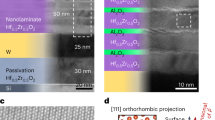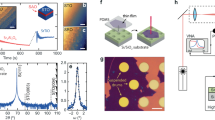Abstract
Nanomechanical resonators that can operate in the super high frequency (3–30 GHz) or the extremely high frequency (30–300 GHz) regime could be of use in the development of stable frequency references, wideband spectral processors and high-resolution resonant sensors. However, such operation requires the dimensions of the mechanical resonators to be reduced to tens of nanometres, and current devices typically rely on transducers, for which miniaturization and chip-scale integration are challenging. Here, we show that integrated nanoelectromechanical transducers can be created using 10-nm-thick ferroelectric hafnium zirconium oxide (Hf0.5Zr0.5O2) films. The transducers are integrated on silicon and aluminium nitride membranes, and can yield resonators with frequencies from 340 kHz to 13 GHz and frequency–quality-factor products of up to 3.97 × 1012. Using electrical and optical probes, we show that the electromechanical transduction behaviour of the Hf0.5Zr0.5O2 film is based on the electrostrictive effect, and highlight the role of nonlinear electromechanical scattering in the operation of the resonator.
This is a preview of subscription content, access via your institution
Access options
Access Nature and 54 other Nature Portfolio journals
Get Nature+, our best-value online-access subscription
$29.99 / 30 days
cancel any time
Subscribe to this journal
Receive 12 digital issues and online access to articles
$119.00 per year
only $9.92 per issue
Buy this article
- Purchase on Springer Link
- Instant access to full article PDF
Prices may be subject to local taxes which are calculated during checkout






Similar content being viewed by others
Data availability
The authors declare that the main data supporting the findings of this study are available within the article and its Supplementary Information. Extra data are available from the corresponding author on request.
References
LaHaye, M. D., Buu, O., Camarota, B. & Schwab, K. C. Approaching the quantum limit of a nanomechanical resonator. Science 304, 74–77 (2004).
Jensen, K., Kim, K. & Zettl, A. An atomic-resolution nanomechanical mass sensor. Nat. Nanotechnol. 3, 533 (2008).
Barson, M. S. et al. Nanomechanical sensing using spins in diamond. Nano Lett. 17, 1496–1503 (2017).
Ramezany, A. & Pourkamali, S. Ultrahigh frequency nanomechanical piezoresistive amplifiers for direct channel-selective receiver front-ends. Nano Lett. 18, 2551–2556 (2018).
Villanueva, L. G. et al. A nanoscale parametric feedback oscillator. Nano Lett. 11, 5054–5059 (2011).
Naing, T. L., Rocheleau, T. O., Ren, Z., Li, S. S. & Nguyen, C. T. C. High-Q UHF spoke-supported ring resonators. J. Microelectromech. Syst. 25, 11–29 (2016).
Pourkamali, S., Ho, G. K. & Ayazi, F. Low-impedance VHF and UHF capacitive silicon bulk acoustic wave resonators—part I: concept and fabrication. IEEE Trans. Electron Devices 54, 2017–2023 (2007).
Ruby, R. et al. Positioning FBAR technology in the frequency and timing domain. IEEE Trans. Ultrason. Ferroelectr. Freq. Control 59, 334–345 (2012).
Cassella, C. et al. Super high frequency aluminum nitride two-dimensional-mode resonators with k t 2 exceeding 4.9%. IEEE Microw. Wirel. Compon. Lett. 27, 105–107 (2017).
Iborra, E., Clement, M., Capilla, J., Olivares, J. & Felmetsger, V. Low-thickness high-quality aluminum nitride films for super high frequency solidly mounted resonators. Thin Solid Films 520, 3060–3063 (2012).
Sinha, N., et al. Ultra thin AlN piezoelectric nano-actuators. In TRANSDUCERS 2009—2009 International Solid-State Sensors, Actuators and Microsystems Conference 469–472 (IEEE, 2009).
Wang, Z. et al. Black phosphorus nanoelectromechanical resonators vibrating at very high frequencies. Nanoscale 7, 877–884 (2015).
Lee, J., Wang, Z., He, K., Shan, J. & Feng, P. X. L. High frequency MoS2 nanomechanical resonators. ACS Nano 7, 6086–6091 (2013).
Bunch, J. S. et al. Electromechanical resonators from graphene sheets. Science 315, 490–493 (2007).
Chen, C. Y. et al. Performance of monolayer graphene nanomechanical resonators with electrical readout. Nat. Nanotechnol. 4, 861–867 (2009).
van der Zande, A. M. et al. Large-scale arrays of single layer graphene resonators. Nano Lett. 10, 4869–4873 (2010).
Eichler, A. et al. Nonlinear damping in mechanical resonators made from carbon nanotubes and graphene. Nat. Nanotechnol. 6, 339–342 (2011).
Böscke, T. S., Müller, J., Bräuhaus, D., Schröder, U. & Böttger, U. Ferroelectricity in hafnium oxide thin films. Appl. Phys. Lett. 99, 102903 (2011).
Mulaosmanovic, H. et al. Switching kinetics in nanoscale hafnium oxide based ferroelectric field-effect transistors. ACS Appl. Mater. Interfaces 9, 3792–3798 (2017).
Chernikova, A. et al. Ultrathin Hf0.5Zr0.5O2 ferroelectric films on Si. ACS Appl. Mater. Interfaces 8, 7232–7237 (2016).
Ghatge, M., Walters, G., Nishida, T., & Tabrizian, R. A nano-mechanical resonator with 10nm hafnium-zirconium oxide ferroelectric transducer. In 2018 IEEE International Electron Devices Meeting (IEDM) 4–6 (IEEE, 2019).
Böscke, T. S. et al. Phase transitions in ferroelectric silicon doped hafnium oxide. Appl. Phys. Lett. 99, 112904 (2011).
Park, M. H. et al. Evolution of phases and ferroelectric properties of thin Hf0.5Zr0.5O2 films according to the thickness and annealing temperature. Appl. Phys. Lett. 102, 242905 (2013).
Park, M. H. et al. Ferroelectricity and antiferroelectricity of doped thin HfO2‐based films. Adv. Mater. 27, 1811–1831 (2015).
Park, M. H. et al. Toward a multifunctional monolithic device based on pyroelectricity and the electrocaloric effect of thin antiferroelectric HfxZr1−xO2 films. Nano Energy 12, 131–140 (2015).
Materlik, R., Künneth, C. & Kersch, A. The origin of ferroelectricity in Hf1−xZrxO2: a computational investigation and a surface energy model. J. Appl. Phys. 117, 134109 (2015).
Schroeder, U. et al. Impact of different dopants on the switching properties of ferroelectric hafnium oxide. Jpn. J. Appl. Phys. 53, 08LE02 (2014).
Sundar, V. & Newnham, R. E. Electrostriction and polarization. Ferroelectrics 135, 431–446 (1992).
Gieseler, J., Novotny, L. & Quidant, R. Thermal nonlinearities in a nanomechanical oscillator. Nat. Phys. 9, 806 (2013).
Segovia-Fernandez, J. & Piazza, G. Thermal nonlinearities in contour mode AlN resonators. J. Microelectromech. Syst. 22, 976–985 (2013).
Ghatge, M., Karri, P., & Tabrizian, R. Power-insensitive silicon crystal-cut for amplitude-stable frequency synthesis. In 2017 IEEE 30th International Conference on Micro Electro Mechanical Systems (MEMS) 76–79 (IEEE, 2017).
Polunin, P. M., Yang, Y., Dykman, M. I., Kenny, T. W. & Shaw, S. W. Characterization of MEMS resonator nonlinearities using the ringdown response. J. Microelectromech. Syst. 25, 297–303 (2016).
Rocas, E., Collado, C., Mateu, J., Campanella, H., & O’Callaghan, J. M. Third order intermodulation distortion in film bulk acoustic resonators at resonance and antiresonance. In 2008 IEEE MTT-S International Microwave Symposium Digest 1259–1262 (IEEE, 2008).
Matheny, M. H., Villanueva, L. G., Karabalin, R. B., Sader, J. E. & Roukes, M. L. Nonlinear mode-coupling in nanomechanical systems. Nano Lett. 13, 1622–1626 (2013).
Ghatge, M. & Tabrizian, R. Exploiting elastic anharmonicity in aluminum nitride matrix for phase-synchronous frequency reference generation. Appl. Phys. Lett. 112, 123503 (2018).
Zhu, J., Ru, C. Q. & Mioduchowski, A. High-order subharmonic parametric resonance of multiple nonlinearly coupled micromechanical nonlinear oscillators. Acta Mech. 212, 69–81 (2010).
Popa, B. I. & Cummer, S. A. Non-reciprocal and highly nonlinear active acoustic metamaterials. Nat. Commun. 5, 3398 (2014).
Lepri, S. & Pikovsky, A. Nonreciprocal wave scattering on nonlinear string-coupled oscillators. Chaos 24, 043119 (2014).
Ghatge, M., Walters, G., Nishida, T. & Tabrizian, R. A non-reciprocal filter using asymmetrically transduced micro-acoustic resonators. IEEE Electron Device Lett. 40, 800–803 (2019).
Acknowledgements
We would like to thank the Nanoscale Research Facility at the University of Florida for the fabrication facilities and N. Rudawski for help with TEM. This work was supported in part by the NSF grants ECCS 1610387 and ECCS 1752206.
Author information
Authors and Affiliations
Contributions
M.G. designed, fabricated and measured the resonators. G.W. fabricated and characterized the Hf0.5Zr0.5O2 ferroelectric film. T.N. and R.T. supervised the project and provided guidance throughout the process. All authors participated in analysing the results and contributed to writing the manuscript. All authors have given approval to the final version of the manuscript.
Corresponding author
Ethics declarations
Competing interests
The authors declare no competing interests.
Additional information
Publisher’s note Springer Nature remains neutral with regard to jurisdictional claims in published maps and institutional affiliations.
Supplementary information
Supplementary Information
Supplementary Sections 1–3, containing Supplementary Figs. 1–8.
Rights and permissions
About this article
Cite this article
Ghatge, M., Walters, G., Nishida, T. et al. An ultrathin integrated nanoelectromechanical transducer based on hafnium zirconium oxide. Nat Electron 2, 506–512 (2019). https://doi.org/10.1038/s41928-019-0305-3
Received:
Revised:
Accepted:
Published:
Issue Date:
DOI: https://doi.org/10.1038/s41928-019-0305-3
This article is cited by
-
Three-dimensional acoustic resonators for massively scalable spectral processors
Nature Electronics (2024)
-
A ferroelectric-gate fin microwave acoustic spectral processor
Nature Electronics (2024)
-
Dynamical control of nanoscale light-matter interactions in low-dimensional quantum materials
Light: Science & Applications (2024)
-
Investigation of ionizing radiation mechanisms on HfO2-based ferroelectric thin-film memories with various configurations
Journal of Materials Science: Materials in Electronics (2024)
-
Nanoelectromechanical resonators for gigahertz frequency control based on hafnia–zirconia–alumina superlattices
Nature Electronics (2023)



